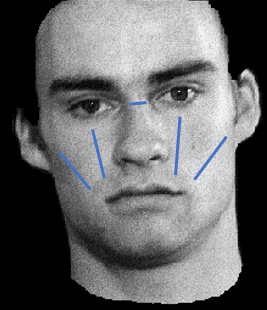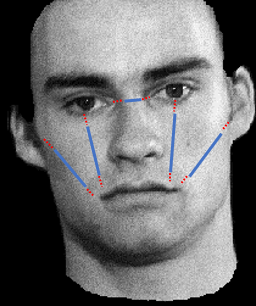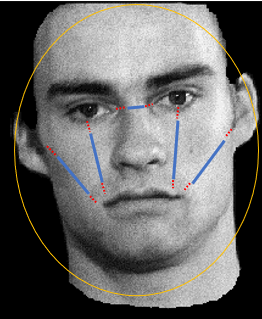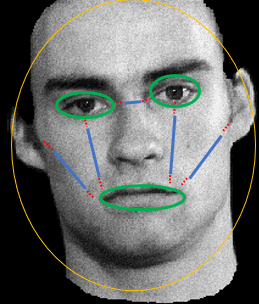Master bio
1/334
There's no tags or description
Looks like no tags are added yet.
Name | Mastery | Learn | Test | Matching | Spaced |
|---|
No study sessions yet.
335 Terms
why do we recognise faces?
best cognitive skills we have
can rapidly detect a face & recognise familiar faces within 100ms
allows us to extract relevant info to categorise a person’s facial expression, gender, race & direction of gaze
why is accurate face recognition important
for social interactions
provides us w/clues about who we are interacting with & motivational/emotional states
behavioural accounts of facial recognition
specificity
expertise
specificity account (Mckine & kanwisher, 2005)
Neurocognitive mechanisms are selectively involved in processing faces
specific to facial recognition
expertise account (Diamond & Carey, 1986'; Gauthier & Tarr)
Neurocognitive mechanisms involved in face recognition are elicited for all prototype-defined stimuli
get better at recognising faces if we’ve seen them before
Face Inversion Effect (FIE)
struggle to recognise faces when they are upside down
unable to process information
Specificity account of FIE (Yin, 1969) Stimuli
p presented w/diff stimuli & asked to remember
more mean errors for inverted faces
more accurate recognition of upright faces
Specificity account of FIE (Yin, 1969) Findings
robust inversion effect for face stimuli than for other stimuli
supports specific account
expertise account of FIE (Diamond & Carey, 1986)
robust inversion effect for dog images as for faces when P were dog breeders
asked to remember what they had seen
performance was equal for non-experts
more accurate recognition of upright
FIE in chimps (Parr & Heinz)
inversion effect suggests chimps have face configural processing
robust inversion effect for faces, not houses (exp1)
chimps have better STM (eidetic) → extracted inner features/spit faces into parts to disrupt configuration
significant impairments when 2nd order configurations are disrupted
performance was improved for inner features
robust FIE
unaltered face, masked eyes, small pixelation & large
pixelating affected 1st/2nd order configurations
significant difference w/large pixelation
configural information (expertise account)
1st order
2nd order
holistic processing
featural processing
1st order configural processing
average spatial relationship among main features
creates a prototype

2nd order configural processing
small variations of average spaces
distance of main features

holistic configural processing
processing face as a whole

Featural configural processing
identifying individual features of the face as if they were separate

Thatcher illusion
manipulation of face & mouth
if inverted don’t notice
if upright is distressing
used to seeing face upright w/specific configural information → messes w/expertise
shows that face processing required configural processing
why does the thatcher illusion support the expertise account
we’re experts in upright faces, not inverted ones
If we were equally good at both orientations → illusion wouldn’t occur
It can be recreated w/other stimuli if p are experts
Thatcher illusion & FIE (Civile, Cook et al, 2020) stimuli
stimuli upright normal, inverted normal & thatcherised
Thatcher illusion & FIE (Civile, Cook et al, 2020) process
presented w/1 face, asked to remember it & say whether old/new
Thatcher illusion & FIE (Civile, Cook et al, 2020) findings
Thatcherized faces make performance so poor FIE was null
already performing poor that thatiscation didn’t effect → configural info was already disrupted
Thatcherized chimp study (Weldon et al (2013) Stimuli
robust FIE for unaltered faces
Thatcherized chimp study (Weldon et al (2013) process
Chimps shown faces (chimp) that were either
normal
Thatcherized
They were tested under upright and inverted conditions.
The task measured their recognition performance
Thatcherized chimp study (Weldon et al (2013) findings
Chimps were not affected by the Thatcherised illusion
don’t rely on same configural processing as humans
fMRI
non-invasive
detects brain activity by detecting changes in oxygen in blood
relies on blood flow & neural activation being coupled
if area is activated blood flow increases & neurons start sending more electrical signals
mri
involves looking at brain to ensure everything is the right size/place
can show any lesions
strengths of fmri
readily available to both clinical & academic researchers
non-invasive
provides high-resolution anatomic scans
Neuroscience explanation of facial recognition
Face Fusion Area (FFA)
FFA
cortical region in fusiform gyrus
activated when p are presented w/face stimulus
FFA Specificity (Kanwisher et al, 1997) stimuli
searched for occipitotemporal areas that might be specialised for face perception whilst p viewed faces
could anatomically localise candidate face areas
Passive viewing of faces
low-level features presented in scrambled condition
faces vs houses
FFA Specificity (Kanwisher et al, 1997) process
Passive viewing of faces
low-level features presented in scrambled condition
faces vs houses
FFA Specificity (Kanwisher et al, 1997) findings
Passive viewing of faces
fusiform gyrus was strongly activated consistently
low-level features presented in scrambled condition
fusiform gyrus was more strongly activated for faces than scrambled
faces vs houses
more strongly activated for faces
strengths of Kanwisher et al’s study
avoided leaving cut/paste marks in scrambled faces
supports specific account of facial recognition
FFA expertise (Gauthier et al) process
used fmri
expertise training w/greebles until fast at categorising
confirmed preference for faces
FFA expertise (Gauthier et al) stimuli
greebles & faces
FFA expertise (Gauthier et al) findings
upright specific activation found for upright faces than greebles
prefrence for faces was strongest in right hemisphere
expertise training w/upright greebles led to increased activation in FFA
started to process greebles holistically
led to greebles being affected by inversion effect
worse at recognised inverted
expertise training leads to what kind of processing
holistic processing which leads to inversion effect
is inversion effect exclusive for faces
no
Gauthier et al found inversion effect could be produced by training p to be experts at greebles
supports the expertise account
Electroencephalogram (EEG)
measure electrical activity generated by synchronised activity of neurons
voltage fluctuations measured is small but recorded data is digitised & sent to amplifier
strengths of EEG
provides excellent time resolution
detection of activity within cortical areas at sub seconds
ERPs
small voltage generated in brain structures in response to specific stimuli
EEG changes that are locked to sensory/cognitive events
provides a noninvasive way of studying psychophysical correlated of mental process w/temporal resolution
FIE on N170 → specificity account (Eimer, 2010)
decreased peak recorded in posterior temporal regions due to faces
FIE increases N170 amplitude & delays peaks → brain is working harder & slower to process inverted faces compared to upright ones
inverted disrupts normal processing
FIE on N170 → specificity account (Eimer, 2010) stimuli
upright vs inverted
FIE on N170 → specificity account (Eimer, 2010) process
EEG measured N170 component during face recognition tasks
FIE on N170 specificity account (Eimer, 2010) findings
suggests face processing relies on holistic processing
N170 is larger for faces = faces processed uniquely
missed because electrodes rarely placed in posterior regions
N170
an ERP component appearing 130-210 seconds after processing faces & familiar objects
associated w/early face perception
typically larger in amplitude & delayed in latency for inverted faces
why does N170/Eimer’s study support specificity account
N170 is selective for faces (not other object categories).
changes in N170 due to inversion imply that face-specific mechanisms are being disrupted.
supports the idea that faces are processed differently
Expertise account of N170 & FIE
specific stimuli can alter N170 inversion effect making it similar to effect of faces
Rossion et al (2002)
Before training N170 was larger for faces
after training inversion effect for greebles was comparable to faces → expertise
Busey & Vanderkolk
fingerprint experts showed a delayed N170 inversion effect for inverted fingerprints
resembled FIE without peaks
ERP, N170 & checkerboards (Civile, Zhao et al, 2014) investigated
ERPs to a recognition task w/checkerboards
ERP, N170 & checkerboards (Civile, Zhao et al, 2014) process
P were trained w/checkerboards & measured using EEG
ERP, N170 & checkerboards (Civile, Zhao et al, 2014) findings
performance for upright familiar was better than upright novel
N170 had a robust effect for familiar inverted
significant delay N170 for familiar inverted
mirroring FIE
supports expertise account as experience w/checkerboards led to holistic processing
Brief history of brain stimulation
electric fish used for treatment of headaches (43 AD)
Galen attempted to alleviate pain using eel but found it needed to be alive to producean electrical current
Torpedo fish used to alleviate headaches/joint pain in middle ages
First electrical battery led to direct stimulation (19th)
Aldini (19th) completed first study of tDCS to improve mood
Transcranial direct current stimulation (tDCS)
target channel electrode & reference channel electrode place on scalp
delivers continuous low electrocurrent stimulation (1-2ma)
Anodol stimulation induces depolarization of resting membrane potential
increased neural excitability allows for spontatious cell firing
stimulation for 9-13 minutes can last hr after
anodal
where you want to stimulate
cathode
reference area
if you wanted cathode stimulation you swap
depends where you put sponge
tDCS & inversion effect (Civile et al, 2021) Process
anode over stimulation area 1.5 mA for 10m
cathode on forehead 1.5 mA for 30s
face matching task & categorisation task (same or diff from target)
tDCS & inversion effect (Civile et al, 2021) findings
cathode/sham produced FIE → better recognition of upright faces than inverted
Anodal stimulation → reduced/eliminated FIE
P were worse at recognising upright faces
10m of stimulation made P reduces ability of recognising faces
suggests a neural basis for the expertise account of FIE
Neurostimulation
new line of research based on using a tDCS procedure
provided evidence that inversion effect for checkboards & faces at lease some of the same causal mechanisms
Inversion effect between familiarised checkboards & faces (Civile, Quagia et al, 2021) process
compare inversion effect between familiarised checkerboards & faces
Face Matching → tDCS slightly reduced inversion effect
Checkerboard Matching → tDCS reduced the inversion effect
Inversion effect between familiarised checkboards & faces (Civile, Quagia et al, 2021) findings
provide evidence for 2 factors contributing to inversion effect
Expertise (modifiable by tDCS)
Face-specific mechanisms (less influenced by tDCS).
what is meant by expertise mechanisms contributing the inversion effect
if familiar w/something = process holistically
whole rather than parts
this is disrupted by when item is inverted
tDCS can disrupt this if placed on posterior parietal cortex
what is meant by face-specific mechanism contributing the inversion effect
Suggests that faces are unique & processed by specialised neural systems (e.g., fusiform face area).
mechanism may be less influenced by tDCS
inversion effects for faces remain stronger or more resilient even after stimulation
Other Race effect (ORE)
refers to the impaired ability to recognise faces from other racial groups
1st demonstrated by Mallpass & Kravists & widely replicated w/different racial groups
higher accuracy in recognising own race faces
real life example of ORE
EWT failures → false convictions due to misidentification
ORE implicated in failures of police matching
who are perpetrators of ORE
individuals who fail to recognise/differentiate other race individuals
ORE study (Michel et al, 2006) stimuli
unfamiliar caucasian & Chinese faces featuring neural expressions & cropped to remove external features
ORE study (Michel et al, 2006) process
P shown 20 faces from each race & asked to memorise
ORE study (Michel et al, 2006) findings
Causaions/asians showed better performance for own race
expertise on those they see most often
How might motivation effect ORE (Berger)
prejudiced racial attitudes reduce motivation to approach/differentiate members of other races
weaker memory for other races
early studies used racially homogenous caucasian students w/little exposure to diff
ORE reflecting different processing
ORE reflect categorical processing of outgroups’ faces vs feature-based processing of ingroup
own race faces = search for individual features
other race = rely on prototypical features resulting in poorer discrimination
face perception is influenced by? (younger et al, 2012)
by social categorisation
based on race, sex & age
different facial features are used depending on whether face elongs to ingroup or outgroup
outgroup facial processing
processed featurally
ingroup facial processing
processed holistically
perceptual expertise argument for ORE
lack of contact/visual experience w/other race faces
results in difficulty in processing other races faces confirgual
size/impact of ORE depends on
amount of interacial ex
FFA & ORE (Golby et al) stimuli
42 AA, 42 EA, 42 radios
FFA & ORE (Golby et al) process
fMRI
shown half previously seen & asked to indicate whether new/old
FFA & ORE (Golby et al) findings
better recognition for own race faces → robust ORE
greater FFA activation for same faces in 84%
perceptual expertise due to exposure to same faces
FFA activation for same-race faces driven by familiarity/expertise w/same race
N170 & ORE (Vizioli et al, 2010) stimuli
15 caucasians, 15 asians
no prior experience w/either
N170 & ORE (Vizioli et al, 2010) process
face presented for 200ms
showed inverted SR or OR
performed orthogonal task to avoid race based attentional bias
N170 & ORE (Vizioli et al, 2010) findings
n170 amplitude largest for inverted SR faces across all groups
greater configural processing disruption when same face are inverted
n170 latency no difference between races
speed of early visual face processing wasn't dependent
behavioural = memorising faces
SR faces were recognised more accurately than OR
ORE
FIE had greater negative effects on SR recognition
supports expertise account
familiarity = holistic
tDCS to eliminate ORE (Civile & Mclaren) aim
examined if tDCS disrupted perceptual expertise for faces & decreased ORE → driven by perceptual expertise
tDCS to eliminate ORE (Civile & Mclaren) stimuli
96 western Caucasians (1/2 sham/anodal)
tDCS to eliminate ORE (Civile & Mclaren) process
anodal stimulation over fusiform gyrus
old/new face recognition w/study phase & FIE
tDCS to eliminate ORE (Civile & Mclaren) findings
tDCS reduced ORE → P became = poor at recognising SR & OR faces
perceptual expertise
tDCS interfered w/holisitic/congiural face processing
objectification theory (Fredrickson & Roberts, 1997)
sexual objectification as appraisal of women in terms of their bodies as objects for utilisation
leading to negative psychological consequences
e.g shame, self-objectification
objectification of women (Nussbaum, 1999)
has negative effects for the objectified person
e.g restrained eating
can be a precursor for dehumanisation
objectification occurs when… (Bartkly, 1990)
woman’s sexual parts functions are separated from her person
reduced to mere instruments
regarded as if they were capable of representing her
Heflick & Goldenberg (2009)
male & female p focus on the appearance of famous woman
tended to dehumanise her & perceive her as less than competent
when asked to focus on her as a woman → described her w/lack of warmth & human traits
Objectifying gaze
subtle everyday objectification
occurs when man visually inspects a woman
particular attention to their body
can impair women’s cognitive abilities
sexual objectification experiences promote…
self-objectification & internalisation of a 3rd person’s perspective of their bodies
women may regard their looks as more important than other aspects e.g health
body surveillance (fredrick & roberts, 1997)
habitual monitoring of the body’s outward appearance
objectifying gaze causes increased body surveillance
body shame (fredrick & roberts, 1997)
emotional response that follows from measuring oneself against an internalised/cultural standard
perceiving oneself to be failing against standards
objectifying gaze increases body shame
gaze focuses attention on body producing shameful response
body dissatisfaction (Smolak & Levine, 2001)
awareness of potential discrepancies between women’s actual bodies & cultural appearance ideals
higher body dissatisfaction when women interpret weight-related criticisms
interpret weight related compliments more positively
when do women experience the most body dissatisfaction? (Gervais et al, 2011)
when they receive a compliment
the results of objectifying gaze (Gervais et al, 2011) aimed
examined effect on undergrad women & men’s cognitive performance & body image outcomes (form)
body surveillance, body shame & body dissatisfaction
results of objectifying gaze (Gervais et al, 2011) process
heterosexuals paired w/confederates of opposite sex (‘worker’)
had to solve math problems under roles
confederates provided objectifying looks (chest) & written feedback focusing on looks
confederate maintained neutral eye contact & feedback
results of objectifying gaze (Gervais et al, 2011) findings
women performed worse than men overall in maths
reduction of skills due to objectification
control women performed similarly to men
main effect of gender was significant
women reported more body surveillance, felt more body shame & experienced more body dissatisfaction
objectification & cognitive processes (Gervais et al, 2012)
objectification similar to the processing of an object
found women’s body parts were recognised better in isolation
men’s body parts were recognised better as a full body (integrated as a whole)
suggests women’s bodies are processed in terms of individual features like object recognition
Bernard et al (2012) → perceptual processing of sexualised images using body inversion effect stimuli
48 sexualised photos of men/women in swimsuits, half presented upright, half inverted
Bernard et al (2012) → perceptual processing of sexualised images using body inversion effect process
identified whether they had previously seen sexualised photos of men/women in swimsuits